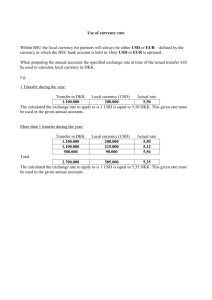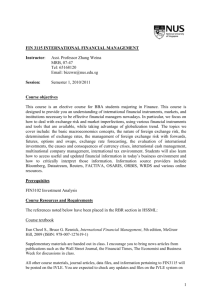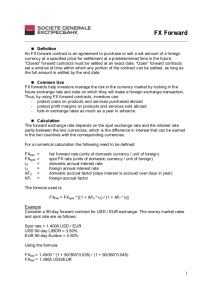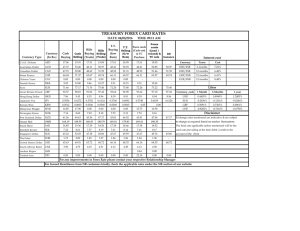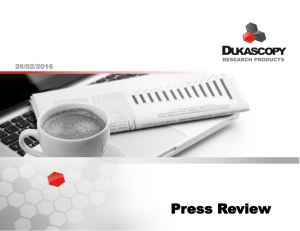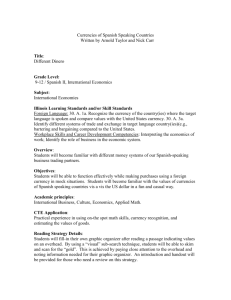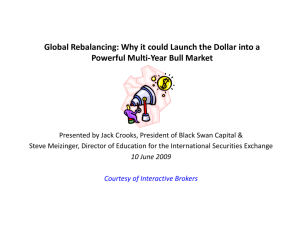FAQs - FREQUENTLY ASKED QUESTIONS
advertisement
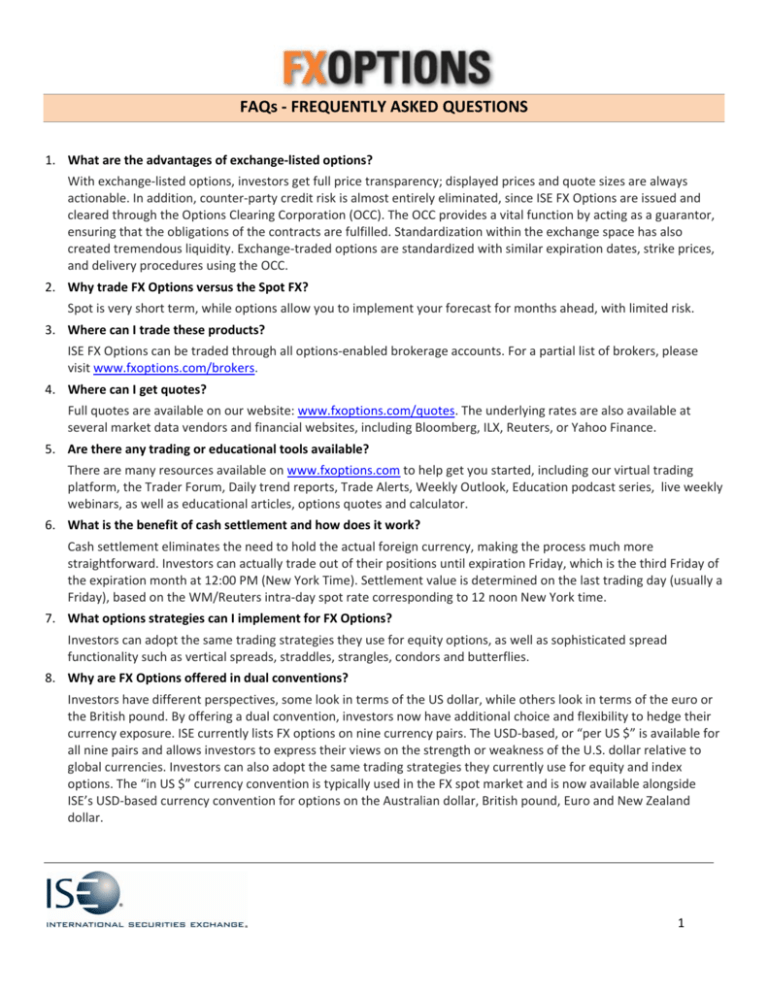
FAQs ‐ FREQUENTLY ASKED QUESTIONS 1. What are the advantages of exchange‐listed options? With exchange‐listed options, investors get full price transparency; displayed prices and quote sizes are always actionable. In addition, counter‐party credit risk is almost entirely eliminated, since ISE FX Options are issued and cleared through the Options Clearing Corporation (OCC). The OCC provides a vital function by acting as a guarantor, ensuring that the obligations of the contracts are fulfilled. Standardization within the exchange space has also created tremendous liquidity. Exchange‐traded options are standardized with similar expiration dates, strike prices, and delivery procedures using the OCC. 2. Why trade FX Options versus the Spot FX? Spot is very short term, while options allow you to implement your forecast for months ahead, with limited risk. 3. Where can I trade these products? ISE FX Options can be traded through all options‐enabled brokerage accounts. For a partial list of brokers, please visit www.fxoptions.com/brokers. 4. Where can I get quotes? Full quotes are available on our website: www.fxoptions.com/quotes. The underlying rates are also available at several market data vendors and financial websites, including Bloomberg, ILX, Reuters, or Yahoo Finance. 5. Are there any trading or educational tools available? There are many resources available on www.fxoptions.com to help get you started, including our virtual trading platform, the Trader Forum, Daily trend reports, Trade Alerts, Weekly Outlook, Education podcast series, live weekly webinars, as well as educational articles, options quotes and calculator. 6. What is the benefit of cash settlement and how does it work? Cash settlement eliminates the need to hold the actual foreign currency, making the process much more straightforward. Investors can actually trade out of their positions until expiration Friday, which is the third Friday of the expiration month at 12:00 PM (New York Time). Settlement value is determined on the last trading day (usually a Friday), based on the WM/Reuters intra‐day spot rate corresponding to 12 noon New York time. 7. What options strategies can I implement for FX Options? Investors can adopt the same trading strategies they use for equity options, as well as sophisticated spread functionality such as vertical spreads, straddles, strangles, condors and butterflies. 8. Why are FX Options offered in dual conventions? Investors have different perspectives, some look in terms of the US dollar, while others look in terms of the euro or the British pound. By offering a dual convention, investors now have additional choice and flexibility to hedge their currency exposure. ISE currently lists FX options on nine currency pairs. The USD‐based, or “per US $” is available for all nine pairs and allows investors to express their views on the strength or weakness of the U.S. dollar relative to global currencies. Investors can also adopt the same trading strategies they currently use for equity and index options. The “in US $” currency convention is typically used in the FX spot market and is now available alongside ISE’s USD‐based currency convention for options on the Australian dollar, British pound, Euro and New Zealand dollar. 1 FAQs ‐ FREQUENTLY ASKED QUESTIONS 9. Do I buy calls or puts to implement my forecast? Always look at it in terms of the base currency. If you are bullish on the base, you buy calls. If you are bearish on the base, you buy puts. There are several ways investors can now trade their views, depending on the base currency. In USD‐based terms, if you are bullish on the USD and bearish on the euro, you buy EUI calls. If you are bearish on the USD and bullish on the euro, you buy EUI puts. In non‐USD terms (i.e. if the base currency was the euro), then if you were bullish on the euro and bearish on the dollar, you buy EUU calls. If you were bearish on the euro and bullish on the dollar, you buy EUU puts. 10. Is there a readily available calculator I can use to view the “Greeks”? Yes, just visit our quotes page at www.fxoptions.com/quotes. 11. What impacts the FX Options currency pair movement? Currency valuations are a product of many factors, not just a single input. The currency market is impacted by macro‐economic factors such as interest rates, GDP, productivity and investment flows. A symbiotic relationship exists between these critical fundamental factors and the currency markets. 12. How do I make my price forecast for FX Options? This is a personal choice for every investor. Some employ fundamental analysis, while others look to technical analysis (charts) such as Fibonacci, Candle Sticks or Moving Averages. Some investors use a mixture of both fundamental and technical analysis. 13. I understand that ISE FX Options are "Exercised" on a European Style basis but can they be bought and sold prior to expiration in order to lock‐in a profit or cut a loss like equity options? Yes, ISE FX Options can be traded throughout the day and do not need to be held till expiration. Since they are European Style, meaning they cannot be exercised till expiration, investors that are short an option, don’t have to worry about early exercise risks. If you are long or short, you can trade out of that position at any time during market hours. 14. Do ISE FX options increase or decrease in value by a given percentage multiple prior to the expiration date? If so, what is this percentage and does this cost correlate with the spot price per pip? No, each option is going to have differing “Deltas”, based on the strike price and time frame selected. In Options, risk is quantified in the “Greeks”, the most important of which is the “Delta.” Delta measures the amount the option should change based on the underlying value ‐ one unit (1 ISE FX value point). The other Greeks also apply in a similar fashion to equity options (Gamma, Theta, Rho and Vega). 15. Is it true that your FX options increments per point is equal to a dollar and that one contract is approximately equal to one Mini‐Lot in the retail FX Spot market? ISE FX Options are options based on the exchange rate itself. They do not carry an exact notional value, but it can be calculated by multiplying 100 x pair value. For example, if USD/YEN (YUK) is trading at 100, just take 100 (premium multiplier) x $100 = $10,000. 16. How would you describe the "Correlation Coefficient Ratio" between your ISE Currency Pair options and the Spot Cash market? Does one normally tend to lead the other market? The correlation is extremely high, since we are mimicking the spot prices on a real‐time basis. 2 FAQs ‐ FREQUENTLY ASKED QUESTIONS Underlying rate = rate x rate modifier To view the product specifications for each currency pair, click on the ISE FX Symbol. Convention USD/AUD USD/CAD USD/CHF USD/EUR USD/GBP USD/JPY USD/MXN USD/NZD USD/SEK Symbol AUX CDD SFC EUI BPX YUK PZO NZD SKA Rate Modifier 100 100 100 100 100 1 10 100 10 Convention AUD/USD EUR/USD GBP/USD NZD/USD Symbol AUM EUU GBP NZO Rate Modifier 100 100 100 100 Rate Examples 125.57 (1.2557 x 100) 116.12 (1.1612 x 100) 108.71 (1.0871 x 100) 77.82 (0.7782 x 100) 61.24 (0.6124 x 100) 96.09 (96.09 x 1) 133.46 (13.346 x 10) 158.16 (1.5816 x 100) 79.57 (7.957 x 10) Rate Examples 86.68 (0.8668 x 100) 147.04 (1.4704 x 100) 160.06 (1.6006 x 100) 71.79 (0.7179 x 100) 17. Which strike price should I buy, given a certain view on a currency pair? Options give so many investment choices, you need to find the right balance, depending on your risk and reward trade‐off. ITM (in‐the‐money) call or put options cost more, but are the most responsive to the underlying exchange rate (Delta), while OTM (out‐the‐money) options have less dollar risk but also lower deltas, which mean they have the lowest responsiveness to the underlying exchange rate. ATM (At‐the‐money) is a hybrid of the two. 18. Is the shortest "Expiration Period" 1 month or are there any shorter expirations period? FX Options are available for varying months, with the longest term being 10 months. 19. What are the aggregate premiums that my broker will charge me? Just like equity options, the premium quoted at the ISE is x 100*. For example, if you buy an option for $2.00, the total premium will be $2.00 x 100 or $200, not including your broker’s commission. This premium is paid in cash (USD) at the time of the trade. 3


